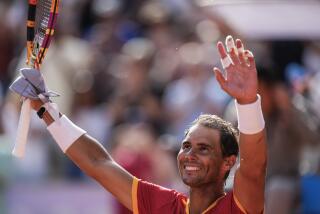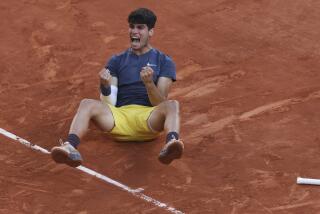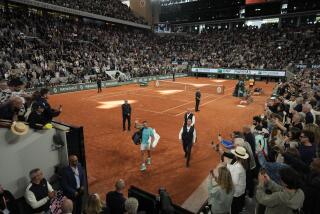Grass Rarely Grows on French Champion
- Share via
PARIS — Perhaps it was coincidence, but Rafael Nadal completed his French Open victory Sunday on his way to the net, driving a forehand volley into the clay to finally subdue Roger Federer after 3 hours and 2 minutes.
Bring on the grass.
The transition from clay to grass is that swift in tennis. With Nadal still basking in the glow of his trophy and a 1-6, 6-1, 6-4, 7-6 (4) victory during a news conference, a reporter noted: “You actually serve-and-volleyed twice, I think, maybe three times.”
Nadal, recognizing the British accent and knowing the thread of questioning, said: “I am thinking.”
Yes, of playing on grass.
Nadal’s grass-court resume is so slight that to expect him to be a force this year is wildly premature. After winning the French Open last year, he traveled to Halle, Germany, and lost in the first round to Alexander Waske. But he did win a round at Wimbledon before losing to Gilles Muller, and in 2003, Nadal defeated Mario Ancic in the first round and went out in the third.
Contrast this to the likes of former French Open champions Thomas Muster, who never won a round at Wimbledon, and Nadal’s Spanish countryman Sergi Bruguera, who for many years never even made the trip to Wimbledon and had a career record of 4-4 there.
Nadal cheerfully acknowledged his singles debut at Queen’s Club in London this week could be a short one.
“I know the normal thing is I’m going to lose in Queen’s first round because it’s very difficult,” Nadal said. “It is very difficult to adapt in two days. But this year I want to play with concentration, with a good chance to play good match because that’s important for the confidence for Wimbledon, no?”
Two-time French Open finalist Alex Corretja, now a commentator for the Spanish network TVE and one of Nadal’s many mentors, was asked how Nadal’s game could adapt on grass. Corretja expressed “doubt” that Nadal would play at Queen’s, though other Spanish journalists thought he would be there.
“How are you going to change your game in two weeks?” Corretja said. “That’s almost impossible. It would be good if there were one more week in between. It’s too close. He needs to recover from that effort to win Monte Carlo, Rome and Paris.”
Nadal has two calling cards to help him on grass -- his left-handed spin and speed. Also, his serve has improved from last year. Footwork is another story.
“It’s very difficult moving the same on grass because I slide a lot on grass, no?” he said. “When I go for a difficult ball, when I come back, I slide....
“But I’m going to try and need to improve that. I’m going to play three weeks consecutive on grass this year. Four is difficult, but I’m going to try.”
That would mean making the second week of Wimbledon. The only other Slam event at which Nadal has made the second week was the Australian Open last year, when he reached the fourth round.
But he was able to shed the label of clay-court specialist in 2005 by winning titles in Montreal on an outdoor hard court and in Madrid on an indoor hard court. He also reached the final in Miami in what has been his only loss to Federer.
His topspin, outside of Paris, could do the most damage at the Australian Open, which features a surface slower than the hard court at the U.S. Open.
Nadal was asked about Bjorn Borg, who set the bar incredibly high by starting off as a dominant clay-court player who went on to make the grass-court transition, winning six French Opens and five Wimbledon titles.
The 20-year-old Nadal knows all that, saying: “Borg was playing early on clay and practicing in Wimbledon. He played no tournament whatsoever before Wimbledon. I will try this year. I don’t think we can change games overnight.”
More to Read
Go beyond the scoreboard
Get the latest on L.A.'s teams in the daily Sports Report newsletter.
You may occasionally receive promotional content from the Los Angeles Times.











